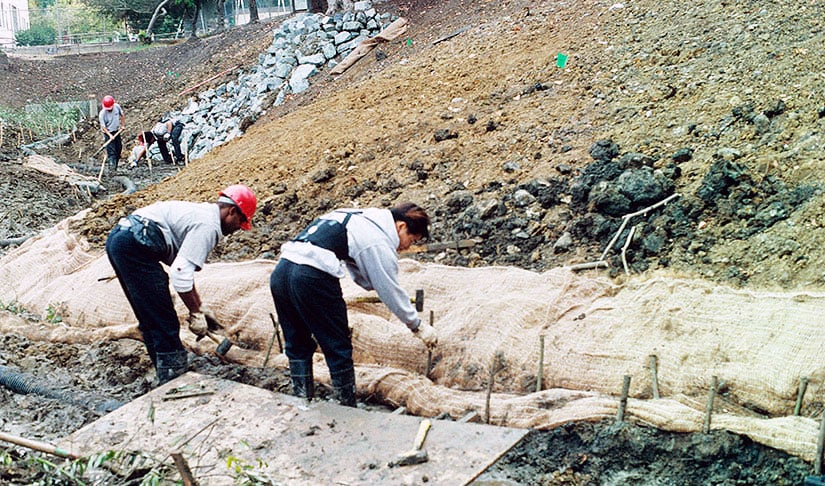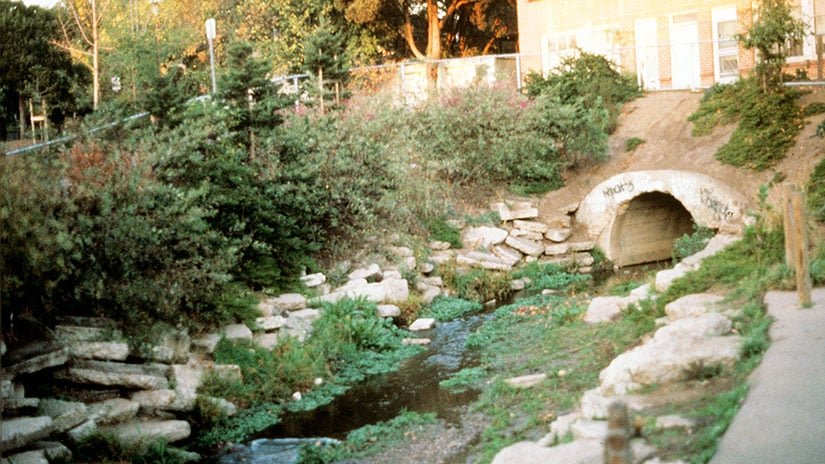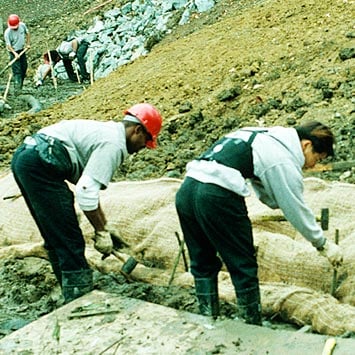The Streams Below Our Streets | San Francisco
Cities once converted streams into sewers to make room for development. But now there’s a growing movement to unearth these buried waterways.
They flow beneath city streets, sidewalks, and even homes: creeks and streams across the United States were once forced underground into sewers, drainpipes, and culverts to make way for urban development.
For more than 30 years, efforts have been made in and around the Berkeley, California area to uncover—or “daylight”—the area’s buried waterways. The term daylighting was coined here in the 1980s, to describe efforts to bring Strawberry Creek back aboveground.
In 1903, a four-acre section of Strawberry Creek had been led into a culvert to allow construction of a Santa Fe Railway right-of-way. When Santa Fe abandoned the property in the early 1980s, the land was acquired by the city, and a park was proposed for the site.
As part of the park’s development, the Berkeley Parks and Recreation Commission planned to remove the 300-foot concrete pipe and expose the enclosed section of water. Although the idea was initially rejected by the city as too expensive and dangerous, the commission eventually implemented the plan. Activists argued that the transformation of the site from a derelict railroad right-of-way to a natural waterway would provide stormwater relief, and create heightened awareness about the ecology of streams.
The groundbreaking project represented the first time a culvert had been dug up and re-created in a channel, and helped pave the way for the formation of the Berkeley-based Urban Creeks Council in 1982. Co-founded by Dr. Ann L. Riley, the Urban Creeks Council was established to foster the preservation, protection, restoration, and management of natural waterways in urban environments. In addition, the non-profit organization works to educate the public on the ecological, aesthetic, and recreational values of restored urban streams.

Riley was introduced to urban stream restoration while she was training in the academic field of fluvial geomorphology with scientist Luna Leopold—who Riley called “the father of modern-day river restoration.” Fluvial geomorphology is the study of how water forms the earth.
“I started trying to take that science and make it into an applied science, and Luna Leopold worked with me on that,” Riley said. “It was painful, for some scientists, but that’s what started happening in the early '80s. So we’re talking about a 35-year history now of a number of people trying to figure out the best way to apply this science and combine it with hydraulic engineering, or civil engineering, plant ecology, fish biology, wildlife biology. So stream restoration means bringing in multiple disciplines and working in teams.”
In 1995, the Urban Creeks Council orchestrated efforts to daylight a 200-foot reach of Blackberry Creek that was flowing through a flood-prone culvert beneath Berkeley’s Thousand Oaks Elementary School. Prior to removing the culvert, stormwater would run off along the streets near the school or even pop up through nearby manhole covers.
The stream restoration project proved a success: a one-in-25-year flood struck California on New Year’s Day 1997, and there was no excessive erosion or flooding from Blackberry Creek into the streets, because a natural stream channel has more space for stormwater than a culvert.
The project also represented a revolution in natural stream engineering. While the engineers at Strawberry Creek had used artificial materials to prevent erosion, here they planted vegetation, and then allowed nature to finish the job.
“We finally got a definition of restoration which is the creek needs to erode, it needs to deposit,” Riley said. “You need to have plants that are interacting with the water, so rather than using gabions, which are rock-filled baskets, riprap rock and concrete, this project uses soil bioengineering, which is a way of bundling native plants, planting them along the channel, and the tensile strength of the roots can be equal to or greater than the tensile strength of the concrete.”
Adding trees and plants along the channel banks can also improve water quality. Stormwater runoff and lawn fertilizers can add excessive amounts of harmful nutrients to urban waterways, including nitrogen and phosphorus. These nutrients can support algae blooms and remove oxygen from the water, killing fish and other aquatic organisms.
Vegetation planted along daylit creeks makes use of threatening nutrients by taking them up in their roots and storing them in their trunks and leaves. The vegetation also helps prevent the growth of algae blooms by shading the water and cooling it down. The churning of the water over rocks adds much-needed oxygen.
Walking the streets of Berkeley, most people are unaware that they might be treading on an underground creek or stream. Riley stresses the importance of educating the public about what could be hiding under their feet.
“People just wanted more developable space, new malls, houses, buildings, right on top of creeks, and also thought that they’re polluted and unsafe so just cover them up and hide them from the city lights—out of sight, out of mind,” Riley explained. “The creek lost the light, because it’s under a lid, in a culvert, and it’s now seeing the light again.”

— Sean Keenehan





